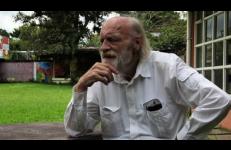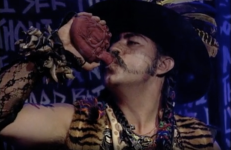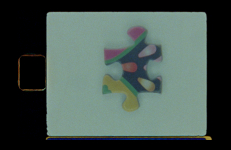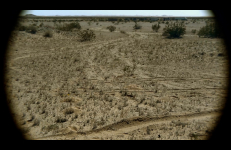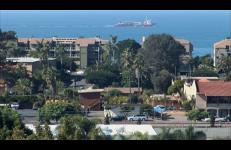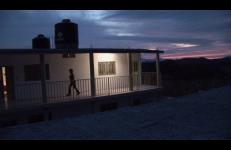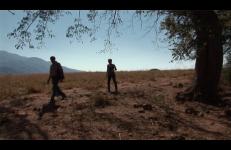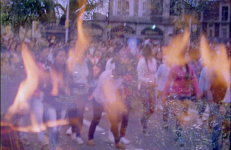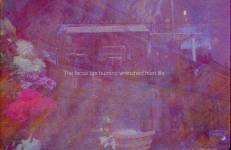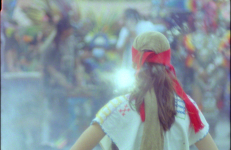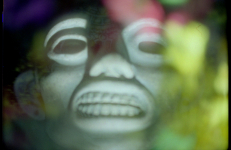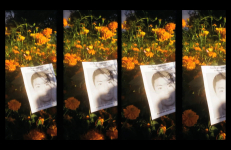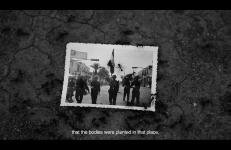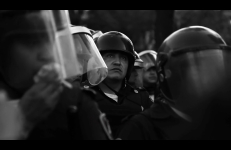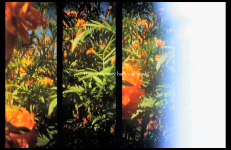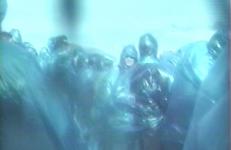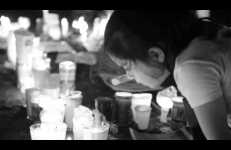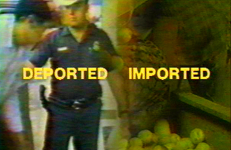In these seven short video performances directed by Isaac Artenstein, Gómez-Peña confronts Mexican-American culture clashes, stereotypes, and the Fourth World (immigrants). Speaking through a bullhorn or on the airwaves of mock-station Radio Latino FM, he broadcasts a message that will not be silenced.
Latino/Chicano
The violent overreaction to 9/11 and to the revolutions of the 1960s cannot be explained only with fear and politics. Franz Hinkelammert, a German-born liberation theologian, economist and philosopher, brings religion front and center to the discussion in a unique way. The emptiness and senselessness felt by those at the margins of a free-market utopian ideology has been filled by an extreme millenarian Christianity and other religious fundamentalisms that justify murder and torture as preemptive self-defense.
A documentation of a performance/installation. Guillermo Gómez-Peña and Roberto Sifuentes created a fictional religion based on inter-cultural confessions. Exhibiting themselves in Plexiglas boxes as "end-of-the-century saints", the two performers hear the confessions of audience members willing to reveal their intercultural fears and desires to the saints.
A documentation of a performance/installation. Guillermo Gómez-Peña and Roberto Sifuentes created a fictional religion based on inter-cultural confessions. Exhibiting themselves in Plexiglas boxes as "end-of-the-century saints", the two performers hear the confessions of audience members willing to reveal their intercultural fears and desires to the saints.
In the center of the rising Temple, the history, myth, ancestral and infrareal combine their rhythms into the cycle life of ritual cinema. Trance and shamanic visions arise into the ancient Teocalli.
Water and paths of migration converge to shape the borderlands along the U.S./Mexico boundary when staging actors in a politicized landscape leads to the rupture of fiction for fact.
terrestrial sea was co-created with Luc Houle.
Cande and Pancha’s daughter Maria Luisa and Marisela and Cachuchas’ daughter Veronica believe their fathers are locked in a competition for grandchildren. It’s now 3-0 Cande. Several years later, Cachuchas gives me a lesson in car repair then with Cande considers the change in score, 4-2 Cande.
Between job losses, foreclosures, living with family, and the Cande’s constant desire to return to Mexico, Pancha and Cande work through the strains of their marital relationship in San Diego County. Not able to have a house of their own, they resume the calmer life of renters, ending with a celebration of Cande’s 58th birthday.
Ramon's attraction to his Mexican hometown has resulted in his building a massive new residence for his family. However, his wife, Rufina and their grown children have no interest in leaving the U.S. The building has now been transformed into a hotel. The completed construction, in the middle of cornfields, while finished for 5 years, is been frustrated by the local government’s refusal to turn on the electricity.
First Ramon, and then Rufina moved to San Diego County in 1980, unable to raise their family as landless sharecroppers in Mexico. Though uneducated, they manage to work as a landscape contractor and housekeeper, respectively, buy a house, and raise 6 children who complete high school and maintain successful management jobs.
The Sun Quartet is a solar composition in four movements, a political composition in four natural elements, an audiovisual composition in four bodily mutations: a sun stone where youth blooms in protest, a river overflowing the streets, the burning plain rising in the city. And, finally, the clamor of the people that shook Mexico after the night of September 26, 2014. The disappearance of 43 students from Ayotzinapa opened a breach in the Mexican political body.
The Sun Quartet is a solar composition in four movements, a political composition in four natural elements, an audiovisual composition in four bodily mutations: a sun stone where youth blooms in protest, a river overflowing the streets, the burning plain rising in the city. And, finally, the clamor of the people that shook Mexico after the night of September 26, 2014. The disappearance of 43 students from Ayotzinapa opened a breach in the Mexican political body.
The Sun Quartet is a solar composition in four movements, a political composition in four natural elements, an audiovisual composition in four bodily mutations: a sun stone where youth blooms in protest, a river overflowing the streets, the burning plain rising in the city. And, finally, the clamor of the people that shook Mexico after the night of September 26, 2014. The disappearance of 43 students from Ayotzinapa opened a breach in the Mexican political body.
The Sun Quartet is a solar composition in four movements, a political composition in four natural elements, an audiovisual composition in four bodily mutations: a sun stone where youth blooms in protest, a river overflowing the streets, the burning plain rising in the city. And, finally, the clamor of the people that shook Mexico after the night of September 26, 2014. The disappearance of 43 students from Ayotzinapa opened a breach in the Mexican political body.
These are the dancing bodies in an agitated rapture: prelude to trance, invocation of the gods, consecration of intermittence. Here our point of view sparkles under the spell and trance of things gathered, fallen, yielding, pluvial, Mesoamerican wind, goddess breath, breeze of sticks. percussive woods.
“Drawing on the ancient Nahuatl concept of the animating soul or life force, Tonalli engages the ritualistic powers of the cinema, summoning fire, flowers, and many moons into a frenetic and mesmerizing in-camera collage. Here, amid thickly swirling images and textured abstractions, the gods of creation and fertility manifest, dissolving into iridescent colors and dense, corporeal rhythms.” NYFF59
The planting of the "cempasuchil" for the celebrations of the "Day of Death" is one of the last jobs that the Ayotzianapa normal students did before they were brutally disappeared, with small Lomokino 35mm cameras, which we had to compose-hit several times since they are manufactured to be disposable, we record the harvest of the season, with the purpose of impregnating in the fragility of the chemical canvas: the earth, no longer that of the common graves but that other earth that gives light to the work of our fellow Normalistas.
Radio reports analyze staged photographs we do not see, showing the victims of a mass murder committed by Mexican soldiers. The politicization of the film accounts for the duality between framing and mis-framing, and also shows the overflowing character of a process of transit.
A brief dialogue between Marianne Renoir and Pierrot and a short description-reading from ‘Pierrot le fou’ about Diego Velázquez – these intersect with a visual moment to constitute the outline of a perception and the occurrence of the idea of ‘el pueblo,’ of a meeting.
La Trinchera Luminosa del Presidente Gonzalo is a recreation of one day at the Canto Grande prison in Peru, following women guerrillas from the Maoist Shining Path movement, from their morning marches to their bedtime chants. Kept isolated in their own cellblocks, the guerrillas refused to acknowledge that they were imprisoned. Their cellblocks were just another front in the People’s War: “shining trenches of combat”. This film shows the intense indoctrination and belief system of the brutal Latin American insurgency.
The film suggests a link between three political figures from the history of Mexican resistance: the Soldadera (woman guerrilla fighter), the Zapatista (member of the Zapatista Army of National Liberation), and the Normalista (students from the Ayotzinapa Normal School).
Turistas deals with the letdown of a world that is pre-mediated and post-digested—a video travelling guide that updates the 19th century artist's Grand Tour and downgrades it to 21st century not-so-Grand status.
—Maria-Christina Villasenor, Associate Curator of Film and Media Arts, Guggenheim Museum
An elegy to the popular demands against ominous social and political events in the recent Mexico.
As documented in The Winner’s Circle and la Migra (the emigrant), the move north brings many changes to family life, specifically mothers going to work and children learning English in school. Hock explores the fact that women often adapt more easily than the men to American life, learning English more rapidly. This becomes a source of conflict between the men and women as they compete for better-paying jobs.
An experimental video about cultural and political disputes surrounding immigration and naturalization processes. Work In Progress explores the effects of the 1986 U.S. Immigration Reform Law and individuals who did not qualify for amnesty under this reform, therefore remaining undocumented.





